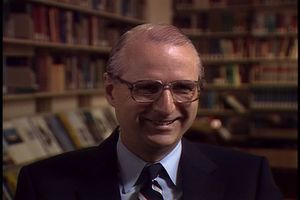War and Peace in the Nuclear Age; Interview with Robert McNamara, 1986 [2]
Item Information
- Title:
- War and Peace in the Nuclear Age; Interview with Robert McNamara, 1986 [2]
- Description:
-
When Robert McNamara moved from president of Ford Motor Company to secretary of defense in 1961, he brought his very active management control and systems-planning philosophy to the Kennedy administration. In his interview conducted for War and Peace in the Nuclear, McNamara recalls how he rejected the doctrine of "massive retaliation" in favor of "flexible response" in order to raise the nuclear threshold and increase the United States' ability to wage limited nuclear and non-nuclear warfare. He outlines the exhaustive review and overhaul of programs he and his analysts conducted early in the Kennedy administration. He rejected not only massive retaliation but also SIOP-62, the blueprint for the use of nuclear weapons in the event of war; consistent overestimates of Soviet nuclear and conventional capabilities; and the very concept of first-strike force. Initially, McNamara embraced a city-avoidance policy and missile programs that would create a menu of alternate strategies to avoid all-out nuclear war. Realizing the infeasibility of limited nuclear war, he turned to the idea of "assured destruction" and focused on building a deterrent around survivable second-strike weapons that could inflict unacceptable damage on the aggressor. By the time he left the Defense Department in 1968 to become president of the World Bank, McNamara had spearheaded significant shifts in both military policy and the structure of U.S. strategic nuclear forces--a structure that remains largely in place today.
- Interviewee:
- McNamara, Robert S., 1916-2009
- Date:
-
March 28, 1986
- Format:
-
Film/Video
- Location:
- WGBH
- Collection (local):
-
American Archive of Public Broadcasting Collection
- Series:
- WGBH > War and Peace in the Nuclear Age
- Subjects:
-
Global Affairs
Military Forces and Armaments
Germany
Nuclear arms control
Flexible response (Nuclear strategy)
Massive retaliation (Nuclear strategy)
Mutual assured destruction
Single Integrated Operational Plan
Nuclear weapons
Brown, Harold, 1927-
Kosygin, Aleksey Nikolayevich, 1904-1980
United States. Air Force. Strategic Air Command
Warsaw Treaty Organization
North Atlantic Treaty Organization
United States. Central Intelligence Agency
Polaris (Missile)
Antimissile missiles
France
Eisenhower, Dwight D. (Dwight David), 1890-1969
Nuclear warfare
Johnson, Lyndon B. (Lyndon Baines), 1908-1973
Kaysen, Carl
Alsop, Stewart
Gaulle, Charles de, 1890-1970
LeMay, Curtis E.
Wilson, Harold, 1916-1995
Nitze, Paul H.
Warfare, Conventional
Kennedy, John F. (John Fitzgerald), 1917-1963
United States. Dept. of Defense
United States
Soviet Union
Deterrence (Strategy)
First strike (Nuclear strategy)
Minuteman (Missile)
- Extent:
- 01:32:59
- Link to Item:
- http://americanarchive.org/catalog/cpb-aacip-15-707wm13t62
- Terms of Use:
-
Rights status not evaluated.
Contact host institution for more information.
- Publisher:
-
WGBH Educational Foundation
![War and Peace in the Nuclear Age; Interview with Robert McNamara, 1986 [2]](https://bpldcassets.blob.core.windows.net/derivatives/metadata/commonwealth-oai:5m60v450c/image_thumbnail_300.jpg)
![Interview with Robert McNamara, 1986 [2]](https://bpldcassets.blob.core.windows.net/derivatives/metadata/commonwealth-oai:08614m274/image_thumbnail_300.jpg)


